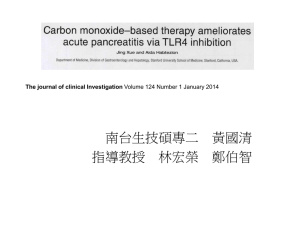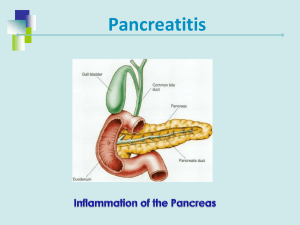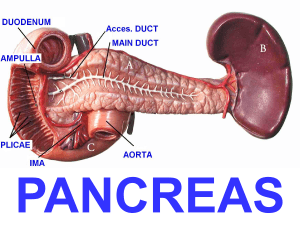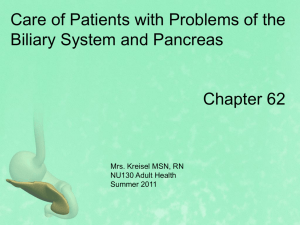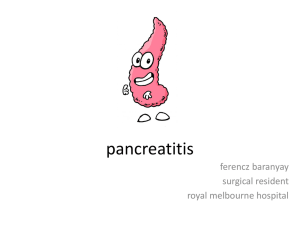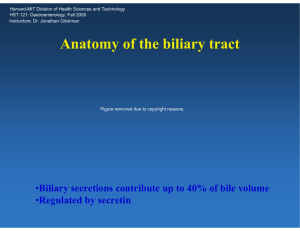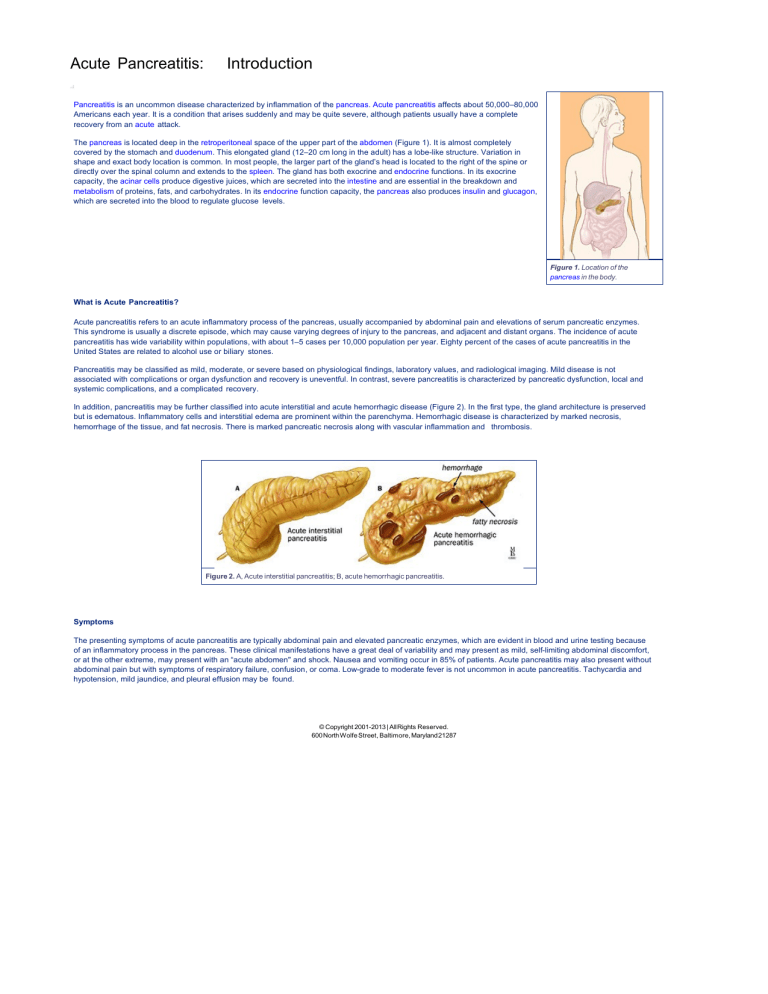
Acute Pancreatitis:
Introduction
Pancreatitis is an uncommon disease characterized by inflammation of the pancreas. Acute pancreatitis affects about 50,000–80,000
Americans each year. It is a condition that arises suddenly and may be quite severe, although patients usually have a complete
recovery from an acute attack.
The pancreas is located deep in the retroperitoneal space of the upper part of the abdomen (Figure 1). It is almost completely
covered by the stomach and duodenum. This elongated gland (12–20 cm long in the adult) has a lobe-like structure. Variation in
shape and exact body location is common. In most people, the larger part of the gland’s head is located to the right of the spine or
directly over the spinal column and extends to the spleen. The gland has both exocrine and endocrine functions. In its exocrine
capacity, the acinar cells produce digestive juices, which are secreted into the intestine and are essential in the breakdown and
metabolism of proteins, fats, and carbohydrates. In its endocrine function capacity, the pancreas also produces insulin and glucagon,
which are secreted into the blood to regulate glucose levels.
Figure 1. Location of the
pancreas in the body.
What is Acute Pancreatitis?
Acute pancreatitis refers to an acute inflammatory process of the pancreas, usually accompanied by abdominal pain and elevations of serum pancreatic enzymes.
This syndrome is usually a discrete episode, which may cause varying degrees of injury to the pancreas, and adjacent and distant organs. The incidence of acute
pancreatitis has wide variability within populations, with about 1–5 cases per 10,000 population per year. Eighty percent of the cases of acute pancreatitis in the
United States are related to alcohol use or biliary stones.
Pancreatitis may be classified as mild, moderate, or severe based on physiological findings, laboratory values, and radiological imaging. Mild disease is not
associated with complications or organ dysfunction and recovery is uneventful. In contrast, severe pancreatitis is characterized by pancreatic dysfunction, local and
systemic complications, and a complicated recovery.
In addition, pancreatitis may be further classified into acute interstitial and acute hemorrhagic disease (Figure 2). In the first type, the gland architecture is preserved
but is edematous. Inflammatory cells and interstitial edema are prominent within the parenchyma. Hemorrhagic disease is characterized by marked necrosis,
hemorrhage of the tissue, and fat necrosis. There is marked pancreatic necrosis along with vascular inflammation and thrombosis.
Figure 2. A, Acute interstitial pancreatitis; B, acute hemorrhagic pancreatitis.
Symptoms
The presenting symptoms of acute pancreatitis are typically abdominal pain and elevated pancreatic enzymes, which are evident in blood and urine testing because
of an inflammatory process in the pancreas. These clinical manifestations have a great deal of variability and may present as mild, self-limiting abdominal discomfort,
or at the other extreme, may present with an “acute abdomen" and shock. Nausea and vomiting occur in 85% of patients. Acute pancreatitis may also present without
abdominal pain but with symptoms of respiratory failure, confusion, or coma. Low-grade to moderate fever is not uncommon in acute pancreatitis. Tachycardia and
hypotension, mild jaundice, and pleural effusion may be found.
© Copyright 2001-2013 | All Rights Reserved.
600 North Wolfe Street, Baltimore, Maryland 21287
Acute Pancreatitis:
Anatomy
Anatomy
The pancreas lies behind the peritoneum of the posterior abdominal wall and is oblique in its orientation. The head of the pancreas is on the right side and lies within
the “C” curve of the duodenum at the second vertebral level (L2). The tip of the pancreas extends across the abdominal cavity almost to the spleen. Collecting ducts
empty digestive juices into the pancreatic duct, which runs from the head to the tail of the organ. The pancreatic duct empties into the duodenum at the duodenal
papilla, alongside the common bile duct (Figure 3).
Figure 3. The pancreas and adjacent anatomy.
The Duct of Wirsung is the main pancreatic duct extending from the tail of the organ to the major duodenal papilla or Ampulla of Vater . The widest part of the duct is
in the head of the pancreas (4 mm), tapering to 2 mm at the tail in adults. The duct of Wirsung is close, and almost parallel, to the distal common bile duct before
combining to form a common duct channel prior to approaching the duodenum. In approximately 70% of people, an accessory pancreatic duct of Santorini (dorsal
pancreatic duct) is present. This duct may communicate with the main pancreatic duct. The degree of communication of the dorsal and ventral duct varies from
patient to patient (Figure 4).
Figure 4. Anatomy of major and minor papilla; A, gross appearance; B, sphincter of Oddi muscles; C,
endoscopic view.
Smooth circular muscle surrounding the end of the common bile duct (biliary sphincter) and main pancreatic duct (pancreatic sphincter) fuses at the level of the
ampulla of Vater and is called the sphincter of Oddi (Figure 4).
This musculature is embryologically, anatomically, and physiologically different from the surrounding smooth musculature of the duodenum. The normal appearance
through the endoscope includes the major and minor papilla. The major papilla extends 1 cm into the duodenum with an orifice diameter of 1 mm. The minor papilla is
20–30 mm proximal and medial. Its orifice is tiny and may be difficult to identify (Figure 4B). Dysfunction of this muscle may result in unexplained abdominal pain or
pancreatitis.
Figure 5. Function of the sphincter of Oddi; A, relaxed; B, contracted.
The sphincter of Oddi is a dynamic structure that relaxes and contracts to change the dimensions of the ampulla of Vater.
The pancreas may be divided into five major regions—the head, neck, body, tail and uncinate process (Figure 6). The distal end of the common bile duct can be
found behind the upper border of the head of the pancreas. This duct courses the posterior aspect of the pancreatic head before passing through the head to reach
the ampulla of Vater (major papilla). The uncinate process is the segment of pancreatic tissue that extends from the posterior of the head. The neck of the pancreas, a
part of the gland 3–4 cm wide, joins the head and body. The pancreatic body lies against the aorta and posterior parietes, and anteriorly contacts the antrum of the
stomach.
Figure 6. Regions of the pancreas.
© Copyright 2001-2013 | All Rights Reserved.
600 North Wolfe Street, Baltimore, Maryland 21287
Acute Pancreatitis:
Causes
Gallstones
Gallstones are the most common cause of pancreatitis in the United States and other Western countries. Biliary tract disease accounts for 35–50% of all cases.
Despite aggressive and intensive early management, the mortality rate is approximately 10%. Although the exact mechanism of acute pancreatitis due to gallstones is
not completely understood, most investigators believe that obstruction of the major papilla by the stone causes reflux of bile into the pancreatic duct (Figure 7). The
presence of bile in the pancreatic duct appears to initiate a complex cascade effect that results in acute pancreatitis.
Figure 7. Gallstone obstruction.
Alcohol
Alcohol is the second leading cause of acute pancreatitis in Western countries. In many patients, however, chronic pancreatitis is already established. Alcohol is
believed to cause acute pancreatitis by several mechanisms. These include abnormal sphincter of Oddi motility, direct toxic and metabolic effects, and small duct
obstruction by protein plug formation (Figure 8).
Figure 8. Alcohol-induced acute pancreatitis.
Drugs
Drugs are a well-recognized cause of pancreatitis. These drugs may be divided into those that have a definite association, and those with probable association with
the development of acute pancreatitis.
Table 01.
Pancreas Divisum
The most common congenital anomaly of the pancreas, pancreas divisum, occurs in approximately 10% of the population, and results from incomplete or absent
fusion of the dorsal and ventralducts during embryological development. In pancreas divisum, the ventral Duct of Wirsung empties into the duodenum through the
major papilla but draining only a small portion of the pancreas (ventral portion). Other regions of the pancreas, including the tail, body, neck and the remainder of the
head, drain secretions into the duodenum through the minor papilla via the dorsal duct of Santorini (Figure 9).
Figure 9. Pancreas divisum.
Recent clinical trials have supported the concept that obstruction of the minor papilla may cause acute pancreatitis or chronic pancreatitis in a subgroup of patients
with pancreas divisum. Endoscopic or surgical therapy directed to the minor papilla has been effective in treating these patients. Figure 9 illustrates the appearance of
pancreas divisum on endoscopic retrograde cholangiopancreatography (ERCP) in which most of the pancreas drains through the dorsal duct (hence the term
dominant dorsal duct syndrome).
Microlithiasis
Recent studies have shown that a significant number of patients with idiopathic acute pancreatitis will have microlithiasis. This may be diagnosed either as gallbladder
sludge on ultrasound (ultrasound of gallbladder sludge) or as crystals on microscopic examination of bile (Figure 10).
Figure 10. Microlithiasis; A, ultrasound image of sludge of microlithiasis; B, microscopic view of crystals
in bile; C, gross appearance.
Treatment of microlithiasis (by cholecystectomy, endoscopic sphincterotomy, or ursodeoxycholic acid) results in a significant reduction in the frequency of attacks of
acute pancreatitis.
Metabolic Causes
Hyperlipidemia and hypercalcemia may lead to acute pancreatitis. In patients with hyperlipidemia, triglyceride levels are usually greater than 2,000mg/dl. It is believed
that lipase present in the pancreatic capillaries metabolizes the levels of triglyceride generating toxic free fatty acids. Hypercalcemia has been shown to induce
experimental pancreatitis, probably by increasing pancreatic duct permeability. Its mechanism for the development of clinical pancreatitis is not clear.
Sphincter of Oddi Dysfunction
In a small group of patients with recurrent pancreatitis of unknown etiology, manometric studies of the sphincter of Oddi have revealed abnormalities in motility.
Clinical studies have shown that therapy, such as endoscopic or surgical sphincterotomy directed to the sphincter of Oddi, may be beneficial in these patients.
Administration of nitrates or calcium channel blockers have provided short-term relief in subsets of patients.
Viral, bacterial, and parasitic infectious causes may lead to pancreatitis with mumps and Coxsackie B viruses being the most common. The human immunodeficiency
virus (HIV) may cause elevation of serum pancreatic enzymes but rarely leads to severe pancreatitis. Bacterial infections that are associated with acute pancreatitis
include Salmonella, Shigella, Campylobacter, Escherichia, Legionella, Leptospira, and even brucella. Pancreatitis associated with these infections is usually
secondary to the release of toxins and usually is not the primary manifestation of such infections.
Miscellaneous
There are multiple other causes of acute pancreatitis that include scorpion stings, poisoning with organophosphorus insecticides, ascaris worms in the pancreatic
duct, and trauma.
© Copyright 2001-2013 | All Rights Reserved.
600 North Wolfe Street, Baltimore, Maryland 21287
Acute Pancreatitis:
Diagnosis
Diagnostic Criteria
Table 2
Table 3
Table 4
Laboratory Testing
In acute pancreatitis, enzymes are released into the blood. Measurements of these enzymes are useful in the diagnosis of acute pancreatitis. The most common
enzymes measured are amylase and lipase. Elevations of amylase are more sensitive, but less specific than lipase in the diagnosis of acute pancreatitis. C-reactive
protein, immunolipase, trypsinogen, and immunoelastase are all elevated following an acute attack of acute pancreatitis. Elevation of alanine aminotransferase and
aspartate aminotransferase is predictive of gallstone pancreatitis.
Radiological Testing
Abdominal radiographs and standard chest films should routinely be performed on patients with severe abdominal pain. Patients with pancreatitis may have a variety
of radiological findings, such as pleural effusion, intestinal gas patterns, colonic obstruction, loss of psoas margins, and increased separation between the stomach
and colon, suggesting inflammation of the pancreas. Calcification in the pancreas or calcified gallstones may also be noted.
Ultrasound and computed tomography (CT) scans may be used to diagnose acute pancreatitis. Ultrasonography is not a sensitive test because overlying intestinal
gas and fatty tissue may obscure the pancreas in over one third of patients. However, ultrasound is very sensitive for the detection of gallstones, bile duct stones, and
bile duct dilatation .
CT is the best diagnostic test for the diagnosis of acute pancreatitis. Contrast-enhanced CT is excellent for diagnosis of pancreatic necrosis. Dynamic CT (performed
by rapid injection of large doses of intravenous contrast) is highly predictive of pancreatic necrosis (Figure 11).
Figure 11. CT scans showing: A, mild; B, moderate; C, severe pancreatitis.
Endoscopic Diagnosis
Gastrointestinal endoscopy allows the physician to visualize and biopsy the mucosa
of the upper gastrointestinal tract. Endoscopy permits visualization of the esophagus, stomach and duodenum. During these procedures, the patient may be given a
pharyngeal topical anesthetic that helps to prevent gagging. Pain medication and a sedative may also be administered before the procedure. The patient is placed in
the left lateral position (Figure 12).
Figure 12. Room set-up and patient positioning for endoscopy.
An endoscope, a thin, flexible, lighted tube, is passed through the mouth and pharynx and into the esophagus. The endoscope transmits an image of the esophagus,
stomach, and duodenum to a monitor, which is visible to the physician. The endoscope is in position for the performance of endoscopic retrograde
cholangiopancreatography (ERCP) when the tip is situated in the region of the major papilla (Figure 13).
Figure 13. Placement of endoscope for ERCP
The endoscopy room is also equipped with an x-ray machine and monitor screen, which are used to help the physician visualize bile and pancreatic ducts. The
endoscope also introduces air into the stomach, expanding the folds of tissue and enhancing the examination of the stomach.
Endoscopic Retrograde Cholangiopancreatography (ERCP)
Figure 14. Side viewing endoscope
ERCP is an endoscopic technique for visualization of the bile and pancreatic ducts. During this procedure, the physician inserts a side-viewing endoscope (Figure 14)
in the duodenum facing the major papilla (Figure 15). The side-viewing endoscope (duodenoscope) is specially designed to facilitate placement of endoscopic
accessories into the bile and pancreatic duct. The endoscopic accessories may be passed through the biopsy channel (Figure 14) into the bile and pancreatic ducts.
A catheter is used to inject dye into both pancreatic and biliary ducts to obtain x-ray images using fluoroscopy (Figure 15). During this procedure, the physician is able
to see two sets of images: the endoscopic image of the duodenum and major papilla, and the fluoroscopic image of the bile and pancreatic ducts.
The scope is designed to be held in the left hand with the thumb operating up and down angulation. The index finger operates the suction and air/water operations.
The right hand is responsible for advancing, withdrawing and torquing the insertion tube. The right hand also operates left and right angulation of the endoscope, and
passes accessories through the instrument.
A variety of instruments can be utilized through the endoscope (Figure 14). Electrosurgical devices such as snares, biopsy forceps, heater probes, BICAP devices for
polyp removal and cauterization, dilation balloons, stents, catheters, and esophageal prostheses can also be used. Lithotripsy devices, injection devices, brushes,
forceps, scissors, and magnetic extraction devices may also be inserted through the endoscope. Cameras may be attached for photo documentation and dual
examiner viewing. Video cameras may also be attached for full-color motion picture viewing during endoscopic procedures or for later review.
ERCP is a sensitive and specific diagnostic tool in acute pancreatitis. ERCP shows details of the pancreatic ductal anatomy including strictures, rupture, and
pseudocysts (Figure 15).
Figure 15. A, Normal biliary and pancreatic ducts during an ERCP; B, ERCP image.
ERCP and Sphincter of Oddi Manometry
Manometry of the sphincter of Oddi requires a sophisticated system to record the motility pattern of the sphincter of Oddi. Measurements are obtained using a special
system of manometry catheters, a hydraulic capillary infusion system, and a computer software program. The fluid infusion system is of low compliance, allowing
direct measurements of the sphincter of Oddi pressure. The standard manometry catheters are triple lumen and made of polyethylene or Teflon. Each catheter lumen
has an internal diameter of 0.5 mm with three side holes at 2-mm intervals starting at 10 mm from the tip. The catheters, which are 200 cm long, have an outer
diameter of 1.7 mm. The pneumatic capillary system perfuses de-ionized, bubble-free water at a pressure of 750 mm Hg at a rate of 0.125 ml/min. Basal sphincter
pressure, amplitude, and frequency of contractions as well as sequences of sphincter contractions may be obtained (Figure 16). Sphincter of Oddi dysfunction is
diagnosed when the basal sphincter pressure is greater than 40 mm Hg.
Figure 16. Sphincter of Oddi manometry; A, Room set-up; B, B’, endoscopic image and position of
manometry catheter.
© Copyright 2001-2013 | All Rights Reserved.
600 North Wolfe Street, Baltimore, Maryland 21287
Acute Pancreatitis:
Therapy
Overview
The most important aspect in the treatment of acute pancreatitis is supportive care. This includes replacement of fluid and electrolytes, correction of metabolic
abnormalities such as symptomatic hypercalcemia, and nutritional support. Other measures such as the use of nasogastric suction and antibiotics should be decided
on a case-by-case basis.
Medical Therapy
Agents that have been used to inhibit pancreatic secretion, including somatostatin and glucagon, have not been found to be useful in altering the course in acute
pancreatitis. Protease inhibitors, which are effective in laboratory studies, have not been shown to be useful in clinical pancreatitis.
Surgical Therapy
Emergency surgery is not indicated in mild acute pancreatitis. Some surgical procedures such as resection of necrotic tissue and peritoneal lavage may have a role in
select patients with severe, progressive necrotizing pancreatitis or pancreatic abscess. Cholecystectomy has been demonstrated to be effective in patients with
recurrent acute pancreatitis and microlithiasis (Figure 17).
Figure 17. A, B, Technique of cholecystectomy with A’, B’, laparoscopic view.
Surgical sphincteroplasty of the pancreatic sphincter is an alternative approach to endoscopic pancreatic sphincterotomy in patients with pancreatic sphincter
dysfunction. Although the patient outcome is the same as for the endoscopic approach, it is more invasive, requiring laparotomy and duodenotomy .
Sphincteroplasty of the minor papilla is indicated for unsuccessful or failed endoscopic minor papilla sphincterotomy in patients with pancreas divisum .
Endoscopic Therapy
Endoscopic therapy has a therapeutic role in three specific areas in the management of acute pancreatitis: 1) acute gallstone pancreatitis, 2) recurrent pancreatitis
due to pancreatic sphincter dysfunction, and 3) recurrent pancreatitis due to pancreas divisum. The rationale for endoscopic therapy in each area is the relief of
obstruction to the flow of pancreatic juice.
Acute Gallstone Pancreatitis
Although it would seem logical that removal of the gallstones from the common bile duct early in acute gallstone pancreatitis would improve the clinical course, there
is a lack of a “predictable” good outcome as suggested by prospective clinical trials. It appears, however, that the patients with suspected stones who benefit from
early ERCP are those with evidence of biliary obstruction such as jaundice or dilation of the bile duct and severe pancreatitis. Further clinical trials are needed before
more definitive recommendations can be made. In a subgroup of patients with acute recurrent pancreatitis and microlithiasis, endoscopic sphincterotomy has been
shown to significantly reduce the frequency of attacks (Figure 18).
Figure 18. A-C, Endoscopic biliary sphincterotomy with stone removal;A',B',endoscopic views and ERCP images.
Recurrent Pancreatitis and Pancreatic Sphincter Dysfunction
With the advent of manometric studies of the pancreatic sphincter, many cases of so-called idiopathic recurrent pancreatitis are now known to be a result of pancreatic
sphincter dysfunction. Endoscopic pancreatic sphincterotomy may be expected to have a good outcome in up to 90% of these patients (Figure 19).
Figure 19.A-D, Endoscopic major papilla sphincterotomy and stent placement, A-D', endoscopic views.
Pancreas Divisum
Endoscopic minor papilla sphincterotomy is an effective treatment for patients with recurrent pancreatitis and pancreas divisum (Figure 20). Good long-term results
are found in about 70% of patients but may be significantly less if there are changes of chronic pancreatitis.
Figure 20. A-C, Endoscopic minor papilla sphincterotomy performed with a pull-type sphincterotome; A’-C’, endoscopic views.
There are two techniques for endoscopic minor papilla sphincterotomy; one is with a pull-type sphincterotome followed by stenting of the pancreatic duct and the
second is with a needle-knife sphincterotome performed over a pancreatic stent (Figure 21). Following pancreatic sphincterotomy there may be tissue swelling that
could result in obstruction to pancreatic outflow. Therefore short-term pancreatic stenting is indicated when pancreatic sphincterotomy is performed to maintain
patency of pancreatic outflow.
Figure 21. A, B, Endoscopic sphincterotomy performed with a needle-knife sphincterotome over a stent;
A’, B’, endoscopic views.
Overview
Complications of acute pancreatitis may result in local or systemic problems. The systemic problems are usually seen in acute, severe pancreatitis. These include
pulmonary complications, such as pulmonary edema and adult respiratory distress syndrome. Inflammatory changes from the pancreas may extend to the kidneys,
stomach, colon and splenic vein (Figure 22). This may result in renal dysfunction, gastrointestinal bleeding, colitis and splenic vein thrombosis. The management of
these complications is supportive.
Local complications include fluid collection, ascites , pancreatic pseudocyst, pancreatic necrosis, and infective pancreatic necrosis. These complications are twice as
frequent in patients with alcoholic and biliary pancreatitis.
Figure 22. Organs involved with inflammatory spread.
Fluid Collections
Fluid collections are common in patients with acute pancreatitis. Simple fluid collections resolve spontaneously in most patients, so therapy is not usually required.
The presence of gas within a fluid collection suggests underlying infection and mandates therapy.
Pseudocysts
The most common complication of acute pancreatitis (occurring in approximately 25% of patients, especially those with alcoholic chronic pancreatitis) is the collection
of pancreatic juices outside of the normal boundaries of the ductal system called pseudocysts (Figure 23A). Most pseudocysts resolve spontaneously. Mature
pseudocysts are enclosed by membranes composed of fibrous tissue and are often situated in the body of the pancreas. They may be classified as communicating
(connecting to the pancreatic duct) or noncommunicating (independent of the pancreatic duct) (Figure 23B).
Figure 23. A, Pancreatic pseudocyst in acute pancreatitis; B, communicating and non-communicating
pseudocysts.
Although the mechanism of pseudocyst formation is speculative, it is thought to result from the rupture of a pancreatic duct, activation of interstitial pancreatic juices,
parenchymal necrosis, intraductal leakage, and local mesothelial cells reacting to wall-off fluid collection by formation of a fibrous membrane.
Pain is the major presenting symptom in cases of pancreatic pseudocysts. Transabdominal ultrasound is helpful in diagnosis and management of pseudocysts. CT
scanning has also proved to be an accurate method of diagnosis and provides structural detail on duct size.
Pseudocysts larger than 6 cm rarely spontaneously resolve. Although conservative management is recommended, intervention should be undertaken when
symptoms of persistent abdominal pain, pseudocyst enlargement or complications occur. Treatment includes excision and internal or external drainage.
Endoscopic Therapy
Diagnostic endoscopic retrograde cholangiopancreatography (ERCP) is performed once the patient is considered an appropriate candidate for endoscopic drainage.
Appropriate identification and management of ductal obstruction is important in management of pseudocysts.
Transpapillary stent placement is recommended as an initial therapy for patients with relatively small pseudocysts that communicate with the main pancreatic duct.
During this procedure, a biliary sphincterotomy is performed along with pancreatic sphincterotomy to avoid the potential for biliary obstruction. Dilation is carried out if
ductal strictures are present. Obstructive pancreatic stones should also be removed. Pancreatic duct stents (usually 7– 8.5 F, thin-walled) are placed in the pancreatic
duct extending into the duodenum (Figure 24). The stent is removed with resolution of the pseudocyst, approximately 4– 6 weeks later. The success rate is greater
than 70%.
Figure 24. Transpapillary stent for communicating pancreatic pseudocyst.
Endoscopic Therapy for Noncommunicating Pseudocyst
Transmural puncture is recommended for patients with large noncommunicating pseudocysts that compress the stomach or duodenum on CT scan. Especially in
patients with complete obstruction of the duct, transmural puncture is the only feasible endoscopic alternative. All patients undergoing this procedure are given
preoperative antibiotics.
A needle-knife sphincterotome is used to create a small incision though the gastric or duodenal wall into the pseudocyst. After needle-knife entry into the pseudocyst
cavity, a guide wire is placed, followed by balloon dilation (Figure 25B). Finally, two or more catheter double-pigtailed stents are placed (Figure 25C), decompressing
the pseudocyst (Figure 25D). Endoscopic ultrasound (EUS) or endoscopic needle localization may be used to guide the puncture and identify a safe entry site into the
pseudocyst.
Figure 25. Endoscopic technique for transgastric pseudocyst drainage.
Surgical Therapy
Surgical management may be indicated for pancreatic pseudocysts with persistent symptoms, cyst enlargement or complications. Anastomosis of the internal
pseudocyst to a portion of the gastrointestinal tract facilitates internal drainage. Usually the stomach, a Roux-en-Y limb of the proximal jejunum, or duodenum may be
used. In cases where a pseudocyst is located in the body of the pancreas adherent to the stomach, a cystogastrostomy is performed (Figure 26A). Anterior
gastrotomy is performed, the cyst is aspirated by needle, and a 3-cm opening made. Anastomosis of the pseudocyst to the posterior gastric wall facilitates pseudocyst
drainage (Figure 26B).
Figure 26. Surgical cystogastrostomy for pancreatic pseudocyst.
The Roux-en-Y cystojejunostomy is useful in draining multiple pseudocysts not adherent to the duodenum or the stomach. During this procedure, the pseudocyst is
entered, its contents evacuated, and it is attached to the jejunal limb .
Pseudocysts in the head of the pancreas are drained into the duodenum by transduodenal cystoduodenostomy. A site in the duodenum, in close proximity to the
pseudocyst, is identified and a lateral duodenotomy is made. The pseudocyst is entered through the medial wall of the duodenum. Sutures are placed to control
bleeding and the lateral duodenotomy is closed.
Percutaneous Therapy
Another treatment option for pseudocyst management in chronic pancreatitis is percutaneous drainage (Figure 27, A and B).
Figure 27. Technique of percutaneous drainage of pancreatic pseudocyst; A, before; and B,
after.
During percutaneous drainage, a needle is inserted through both gastric walls while the position of the catheter is monitored with a gastroscope or fluoroscope .
Pseudocyst drainage into the stomach may be facilitated by placement of a double-pigtailed catheter. Alternately, an indwelling J-shaped catheter (Figure 28)
facilitates external drainage and may be used in cases where pseudocyst contents are viscous. These methods are less invasive than surgery and provide an
alternative for patients who are at high risk for surgical management.
Figure 28. X-ray of indwelling J catheter for pancreatic pseudocyst drainage.
Pancreatic Necrosis
Pancreatic necrosis is a significant complication of acute pancreatitis, and may result in mortality rates as high as 15%. Whatever the mechanism of acute
pancreatitis, in necrotizing pancreatitis, there is obstruction of the pancreatic microcirculation (Figure 29). This may be demonstrated by CT imaging, in which
intravenously administered contrast materials will not appear in areas of necrosis. Dynamic contrast-enhanced CT is the gold standard for the detection of pancreatic
necrosis, with accuracy of greater than 90%.
Figure 29. Pancreatic necrosis
Infection Prevention
Larger, controlled studies are needed to ascertain the effectiveness of prophylactic lavage and antibiotic therapy for the prevention of infection in patients with acute
pancreatitis. Peritoneal lavage with 50 L/day and long-term lavage have been used in patients with severe necrosis to prevent infection. Ciprofloxacin, ofloxacin,
imipenem, and metronidazole have been shown efficacious in infection prevention, although a combination of antibiotics may be most beneficial.
Infection Detection
Abdominal radiographs and CT scans are useful for the identification of areas of infection. CT-guided needle aspiration of suspected infections should be examined
and cultured.
Monomicrobial infection is uncommon but successfully treated, whereas the more frequent finding of polymicrobial infection is more resistant and leads to a poorer
prognosis.
Treatment
Treatment of infected pancreatic necrosis depends on the pattern and anatomic location. Surgical debridement of necrotic tissue or percutaneous drainage comprise
the treatment options. Surgical debridement of infected tissue found early in the course of pancreatitis reduces mortality rates.
Pulmonary Involvement
Fluid accumulation within the pleural space with resultant lung compression, and respiratory distress syndrome are serious complications of pancreatitis. Acute
pleural fluid collection, pancreatic-pleural fistula , and effusions may result from acute inflammation of the pancreas. Most often, pleural effusions spontaneously
resolve; however, thoracentesis is suggested in the face of respiratory compromise or infection. Respiratory support with peritoneal lavage has been shown to
improve lung function in patients with severe adult respiratory distress syndrome.
Other Complications
Renal dysfunction may accompany acute pancreatitis by direct extension of inflammation to the kidney. Erosion of vascular structures by abscesses or pseudocysts
may cause gastrointestinal hemorrhage. Extension of pancreatic inflammation may also lead to colonic strictures, fistulas and perforation. The inflammatory process
may lead to splenic vein thrombosis or pseudocyst formation in the spleen (Figure 30).
Figure 30. Splenic vein thrombosis with splenomegaly.
Splenectomy (Figure 31) is the preferred treatment for splenic vein thrombosis, pseudoaneurysm, or rupture.
Figure 31. Splenectomy; A, preoperative; B, postoperative.
© Copyright 2001-2013 | All Rights Reserved.
600 North Wolfe Street, Baltimore, Maryland 21287

